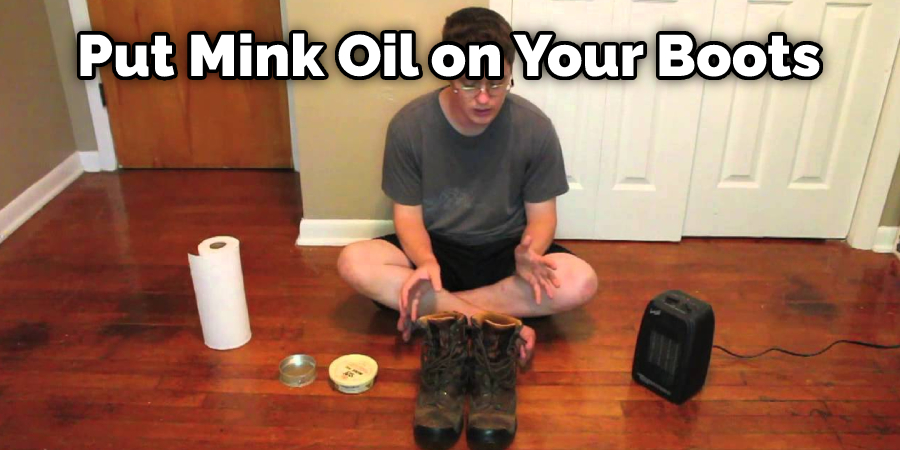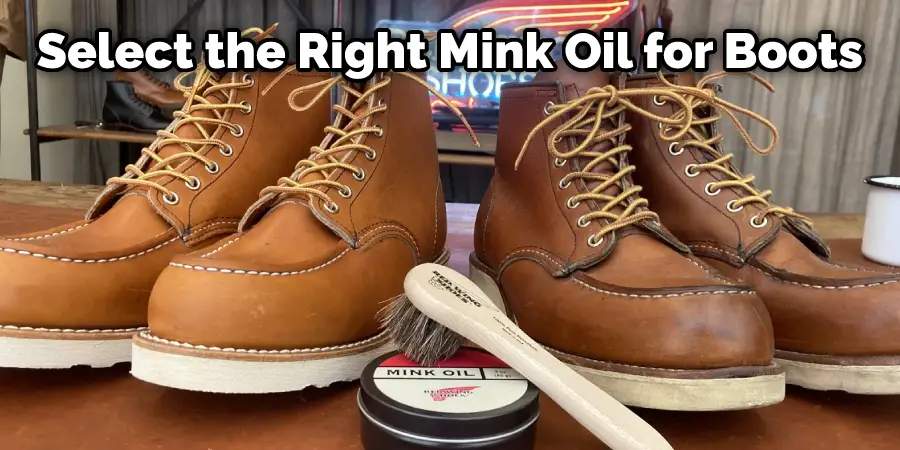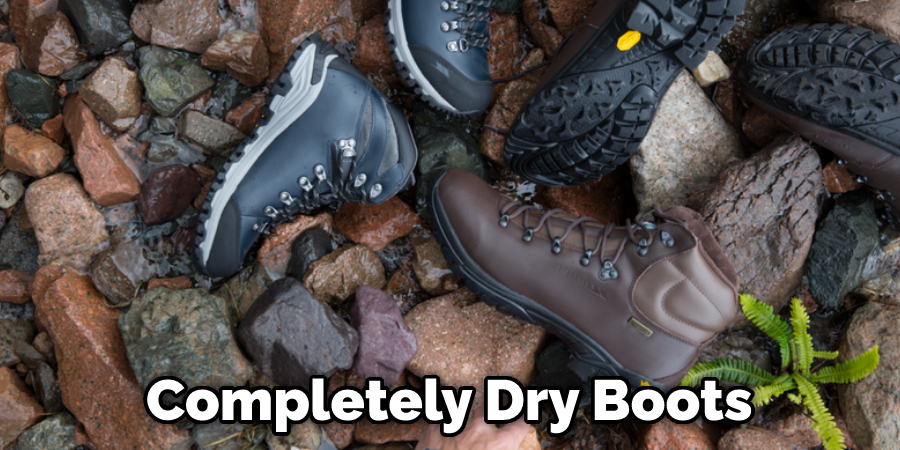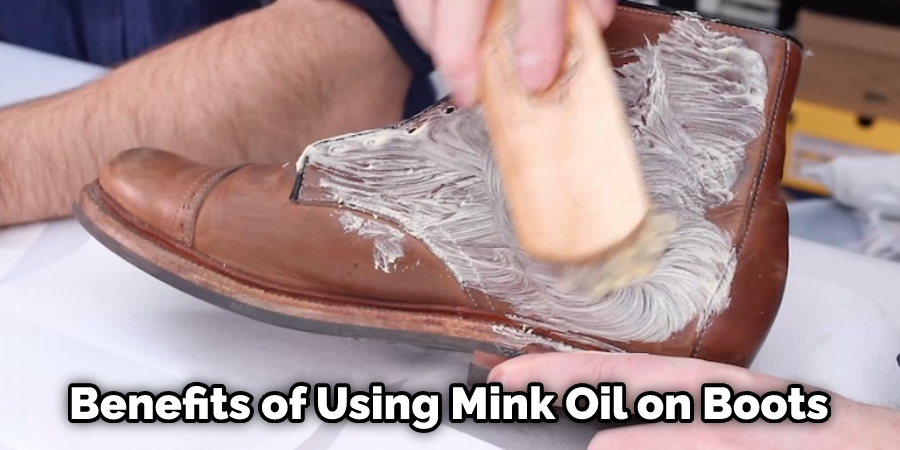Mink oil is a natural product that is derived from the minks hair. It is often used on leather to protect and condition it but can also be used on boots. Mink oil will help to protect your shoes from water, salt, and snow, which can cause them to deteriorate over time. Additionally, mink oil will help to soften the leather and make it more pliable. If you are looking for a way to extend the life of your boots, using mink oil is a great option. In this article, we’ll discuss how to use mink oil on boots. Keep reading.

Boots are an essential part of any winter wardrobe, but they can be expensive. So if you want to prolong the life of your boots and keep them looking their best, it’s essential to take care of them. One way to do this is by using mink oil. Mink oil is often used on leather to protect and condition it but can also be used on boots. Mink oil will help to protect your boots from water, salt, and snow, which can cause them to deteriorate over time.
Summary: Mink oil is a popular product used to condition and waterproof leather boots. To use it on your boots, you first need to clean them thoroughly and let them dry completely. Then, apply a small amount of mink oil to the boots using a soft, clean cloth or brush. Work the oil into the leather, focusing on any scuffs or dry spots. Allow the boots to sit and absorb the oil for several hours or overnight.
What Is Mink Oil?
Mink oil is a natural substance derived from the fat of mink, an animal found exclusively on land. This oil is prized for its unique properties, which include excellent lubrication and water-repellent qualities that make it a popular ingredient in products such as leather conditioners and waterproof coatings.
In addition, mink oil is a valuable source of essential fatty acids and nutrients that are important for maintaining healthy skin and hair. Thanks to these characteristics, mink oil remain one of the most widely used ingredients in personal care products worldwide.
Should I Put Mink Oil on My Boots?
Whether or not to put mink oil on your boots is a difficult decision that ultimately depends on several different factors. On the one hand, mink oil is known for its protective and moisturizing properties, which can help preserve the life of your boots over time.

However, adding too much mink oil can also cause your boots to become saturated, which can lead to fungal growth or other problems down the line. Ultimately, whether or not you should put mink oil on your boots is a decision that only you can make based on your individual needs and preferences.
Some people might choose to add small amounts of mink oil from time to time, while others may decide that it’s better to skip it altogether and focus on regular boot care instead. In any case, it’s important to do thorough research before making a final decision about whether or not you should use mink oil on your boots. Doing so can help ensure that they stay in great condition for as long as possible.
A Step by Step Guide on How to Use Mink Oil on Boots
Step 1: Choose the Best Mink Oil for Your Boots
Selecting the right mink oil for your boots is essential to keeping them looking their best. However, there are a few things to consider when making your selection.
The first thing to think about is the climate you live in. If you live in an area with a lot of moisture in the air, you’ll want to choose a mink oil that’s designed for waterproofing. On the other hand, if you live in a dry climate, you might not need as much waterproofing and can choose an oil that’s designed more for conditioning.
Another thing to consider is the type of leather your boots are made from. Mink oil is typically safe for all types of leather, but some oils are specifically formulated for certain types of leather, such as suede or nubuck. Make sure you choose an oil that is suitable for your boots to get the most benefit from it.
Once you’ve selected a mink oil, be sure to follow the instructions on the bottle carefully when applying it to your boots. This will help ensure optimal protection and conditioning without making them look greasy or sticky.

If you take the time to select the right mink oil for your boots and use it correctly, they will stay looking great for years to come. So, find the best product for your needs, and enjoy your well-cared-for boots!
Step 2: Prepare Your Boots for Mink Oiling
Before you start applying mink oil to your boots, it’s crucial to prep them first. This will help the oil penetrate the leather more deeply and evenly, resulting in better protection and conditioning.
Start by giving your boots a good cleaning with a leather cleaner or saddle soap. This will remove any dirt, grime, or salt that could prevent the mink oil from penetrating the leather. Once they’re clean, dry them thoroughly before moving on to the next step.
If your boots are particularly dry or have been damaged by water, you may want to apply a leather conditioner before using mink oil. This will help replenish lost moisture and prepare the leather for treatment. First, apply the conditioner according to the instructions, then allow it to soak in for a few minutes before moving on to the next step.
Once your boots are clean, conditioned, and dry, you’re ready to apply the mink oil. Follow the bottle or package directions carefully and enjoy your beautifully moisturized and protected boots!
Step 3: Apply Mink Oil to Your Boots
The application process for mink oil is relatively simple, but it’s essential to take your time and avoid getting any of the oil on any other surfaces.
Start by dipping a clean cloth or brush into the mink oil, then gently rub it into the leather. Be sure to apply only a thin coat – you don’t want your boots to look too greasy or shiny!
If you’re treating large areas like uppers or vamps, you may find it easier to use a sponge instead of a cloth or brush. Make sure that whatever tool you choose has an even and light coating of mink oil before applying it to your boots.
Continue applying coats until the leather is evenly saturated, then allow the oil to soak in for a few minutes. Once it’s had a chance to penetrate the leather, you can buff away any excess with a clean cloth.
Step 4: Let Your Boots Dry
After applying the mink oil, it’s essential to let your boots dry completely before wearing them. This will prevent excess moisture from building up and potentially damaging the leather over time.

To hasten the drying process, you may want to set your boots somewhere warm and out of direct sunlight. If there is a lot of excess oil on the surface, you can also gently buff it away with a clean cloth after they’ve had a chance to dry.
Once your boots are fully dry, they’re ready to wear! So enjoy all the benefits of using mink oil on your boots and keep them looking great for years to come.
Mink oil is a great way to protect and condition your boots, but it’s essential to use it correctly. Follow these steps carefully to get the most out of this treatment and keep your boots looking their best. These steps will help in how to use mink oil on boots.
Things to Consider Before Applying Mink Oil to Your Boots
When it comes to caring for your boots, mink oil is one of the most influential and popular materials. This product works by nourishing and protecting the leather from moisture and wear, helping your boots maintain their look and durability over time. However, before applying this substance to your boots, there are a few things that you should keep in mind.
The first thing to consider is the type of leather that your boots are made of. Different types of leather have different needs for care and maintenance, so be sure to do some research beforehand to determine what kind of treatment your particular pair requires.
Additionally, you will also want to think about how often you plan on wearing your boots. If they are only going to get occasional use, you may only need to apply mink oil a few times per year. However, if your boots are in more frequent or heavier use, you may want to consider applying them more regularly.
When it comes to applying mink oil to your boots, there are several different methods that you can try. Some people prefer using a soft cloth or sponge for even application, while others massage the oil into their leather with their hands. Whichever method works best for you will depend on your personal preferences and the state of your boots.
What are the Benefits of Using Mink Oil on Boots?
Mink oil is a popular leather treatment used to keep boots looking and feeling soft, supple, and in good condition. This natural oil contains several beneficial compounds that can help protect your boots from moisture damage while improving their overall appearance. Here are just some of the key benefits of using mink oil on your boots:

– Moisturizes and softens dry or cracked leather: Mink oil is a highly-effective moisturizer that helps keep dry and cracked leather looking and feeling supple.
– Protects against water damage and other types of wear and tear: Mink oil forms a durable, waterproof barrier that helps protect your boots from water and different kinds of damage.
– Helps restore luster to dull or faded leather surfaces: Mink oil can help restore the luster and shine to dull or faded leather boots, making them look and feel like new again.
– Can be applied easily at home with minimal effort or specialized tools: Applying mink oil to your boots is generally a simple and straightforward process that can be done at home with minimal effort or specialized tools. So whether you’re looking to keep your favorite leather boots in good condition or need to restore old or damaged boots to their former glory, using mink oil is a great way to get the results you’re looking for.
– May improve the overall durability and longevity of your boots: In addition to the immediate benefits of using mink oil on your boots, this treatment can also help improve their overall durability and longevity. Regularly treating your boots with mink oil can help extend their lifespan significantly, saving you money in the long run.
Frequently Asked Questions
Can You Put Too Much Mink Oil on Boots?
Yes, putting too much mink oil on boots can cause an allergic reaction in some people. The reason why is because mink oil is a complex compound and contains many allergens. If you are allergic to any of the components in mink oil, you could suffer from an allergic reaction when using it. Therefore, it is important to test any new product or formulation for allergies before using it on your skin.
What Should I Use to Apply Mink Oil on My Boots?
The best way to apply it is by using a mink oil brush or applicator. You can also use it as a natural fixative for jewelry and other accessories. Simply take a small amount of the oil and massage it into the item you want to protect before applying some beeswax or carnauba wax over top.
Do You Wipe Mink Oil Off?
No. While mink oil is a natural moisturizer and may help to protect the leather from water damage, it is not recommended that you wipe it off your boots. Doing so could actually cause more harm than good because the oil will dry out and crack the leather. Instead, use a damp cloth or sponge to clean them gently after each wear.
Conclusion
So, there you have it! Everything you need to know about how to use mink oil on boots. Your boots will look and feel better than ever before by following these simple steps. So, have fun giving them a try!

